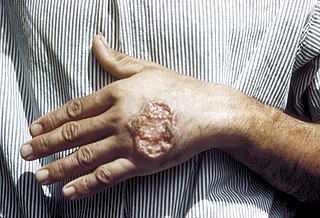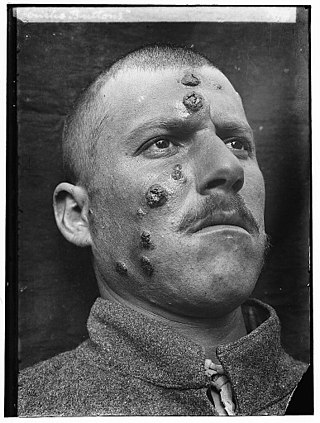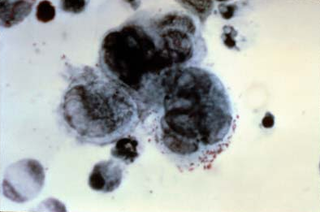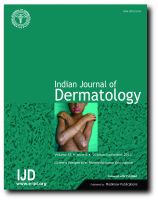Related Research Articles

Leishmaniasis is a wide array of clinical manifestations caused by parasites of the Trypanosomatida genus Leishmania. It is generally spread through the bite of phlebotomine sandflies, Phlebotomus and Lutzomyia, and occurs most frequently in the tropics and sub-tropics of Africa, Asia, the Americas, and southern Europe. The disease can present in three main ways: cutaneous, mucocutaneous, or visceral. The cutaneous form presents with skin ulcers, while the mucocutaneous form presents with ulcers of the skin, mouth, and nose. The visceral form starts with skin ulcers and later presents with fever, low red blood cell count, and enlarged spleen and liver.

Hematidrosis, also called hematohidrosis, haematidrosis, hemidrosis and blood sweat, is a very rare condition in which a human sweats blood. The term is from Ancient Greek haîma/haímatos, meaning blood, and hīdrṓs, meaning sweat.

Hyperpigmentation is the darkening of an area of skin or nails caused by increased melanin.

A seborrheic keratosis is a non-cancerous (benign) skin tumour that originates from cells, namely keratinocytes, in the outer layer of the skin called the epidermis. Like liver spots, seborrheic keratoses are seen more often as people age.
Aquagenic pruritus is a skin condition characterized by the development of severe, intense, prickling-like epidermal itching without observable skin lesions and evoked by contact with water.

Cutaneous leishmaniasis is the most common form of leishmaniasis affecting humans. It is a skin infection caused by a single-celled parasite that is transmitted by the bite of a phlebotomine sand fly. There are about thirty species of Leishmania that may cause cutaneous leishmaniasis.

Erythema toxicum neonatorum is a common, non-threatening rash in newborns. It appears in 4-70% of newborns within the first week of life, and it typically improves within 1–2 weeks. It only occurs during the newborn period, but may appear slightly later in premature babies. The rash has a variable appearance. It typically includes blotchy red spots, often with overlying firm, yellow-white bumps or pus-filled boils. There may be only a few or many lesions. The lesions can appear almost anywhere on the body, and individual lesions may appear and disappear within hours. There are no other symptoms associated with erythema toxicum neonatorum, and the rash does not have any long-term effects on the skin. Erythema toxicum neonatorum is not harmful and does not require any treatment.

Serpiginous, first known to be used in the 15th century, is a term from Latin serpere to creep, usually referring to a creeping, snakelike or slowly progressive skin disease.
Gottron's sign is a pathognomonic cutaneous manifestation associated with dermatomyositis (DM), which is an inflammatory disorder affecting the skin and muscles. The primary lesion of dermatomyositis appears as a violaceous, macular erythema with a symmetric distribution, which may progress and become poikilodermatous and indurated.

In dermatopathology, the Tzanck test, also Tzanck smear, is scraping of an ulcer base to look for Tzanck cells. It is sometimes also called the chickenpox skin test and the herpes skin test. It is a simple, low-cost, and rapid office based test.

Robert Allen Schwartz is an American physician, biomedical researcher, university professor, and government official. He is Professor and Head of Dermatology, Professor of Medicine, Professor of Pediatrics, and Professor of Preventive Medicine and Community Health at the Rutgers New Jersey Medical School, Visiting Professor and Scholar of Public Affairs and Administration at the Rutgers School of Public Affairs and Administration, and serves on the Rutgers University Board of Trustees. He has made seminal contributions to medicine, including the discovery of AIDS-associated Kaposi sarcoma (KS-AIDS) and Schwartz–Burgess syndrome. In 2019 Schwartz joined the Trump administration as a member of the Presidential Advisory Council on HIV/AIDS.

Leishmania tropica is a flagellate parasite and the cause of anthroponotic cutaneous leishmaniasis in humans. This parasite is restricted to Afro-Eurasia and is a common cause of infection in Afghanistan, Iran, Syria, Yemen, Algeria, Morocco, and northern India.

Transient neonatal pustular melanosis (TNPM), also known as pustular melanosis, is a type of neonatal pustular eruption that is a transient rash common in newborns. It is vesiculopustular rash made up of 1–3 mm fluid-filled lesions that rupture, leaving behind a collarette of scale and a brown macule. The lesions are fragile and with no surrounding erythema. This rash occurs only in the newborn stage, usually appearing a few days after birth, but pigmented macules are sometimes already present at birth. The rash usually fades over three to four weeks but may linger for up to three months after birth. It can occur anywhere on the body, including the palms and soles.
Actinic granuloma (AG) was first described by O'Brien in 1975 as a rare granulomatous disease. Lesions appear on sun-exposed areas, usually on the face, neck, and scalp, with a slight preference for middle-aged women. They are typically asymptomatic, single or multiple, annular or polycyclic lesions measuring up to 6 cm in diameter, with slow centrifugal expansion, an erythematous elevated edge, and a hypopigmented, atrophic center.
Granuloma multiforme is a cutaneous condition most commonly seen in central Africa, and rarely elsewhere, characterized by skin lesions that are on the upper trunk and arms in sun-exposed areas. It may be confused with tuberculoid leprosy, with which it has clinical similarities. The condition was first noted by Gosset in the 1940s, but it was not until 1964 that Leiker coined the term to describe "a disease resembling leprosy" in his study in Nigeria.
Histoid leprosy is a skin condition, a rare form of multibacillary leprosy. It can occur in those with relapsing leprosy after undergoing antibiotic therapy with dapsone, or less frequently in the first infection.

Post-kala-azar dermal leishmaniasis (PKDL) is a complication of visceral leishmaniasis (VL); it is characterised by a macular, maculopapular, and nodular rash in a patient who has recovered from VL and who is otherwise well. The rash usually starts around the mouth from where it spreads to other parts of the body depending on severity.

Livedoid vasculopathy is a chronic cutaneous disease seen predominantly in young to middle-aged women. One acronym used to describe its features is "Painful purpuric ulcers with reticular pattern of the lower extremities" (PURPLE).

The Indian Journal of Dermatology is a bimonthly peer-reviewed open-access medical journal published on behalf of the Indian Association of Dermatologists, Venereologists and Leprologists, West Bengal Branch. The journal covers clinical and experimental dermatology, cutaneous biology, dermatological therapeutics, cosmetic dermatology, dermatopathology, and dermatosurgery.

Topical glucocorticoids are the topical forms of glucocorticoids. Topical glucocorticoids are used in the treatment of many skin conditions. They provide anti-inflammatory, antimitotic, and immune-system suppressing actions through various mechanisms.
References
- ↑ "Appropriate Screening for Leishmaniasis before Immunosuppressive Treatments" (PDF). U.S.: U.S. Department of Health & Human Services, USA.gov.
- ↑ Sadeghian, Giti; Ziaei, Hengameh; Bidabadi, Leila Shirani; Nilforoushzadeh, Mohammad Ali (2013). "Evaluation of Leishmanin Skin Test Reaction in Different Variants of Cutaneous Leishmaniasis". Indian Journal of Dermatology. 58 (3): 239. doi: 10.4103/0019-5154.110838 . ISSN 0019-5154. PMC 3667292 . PMID 23723480.
- ↑ Manzur, A.; Bari, Arfan ul (2006-05-30). "Sensitivity of leishmanin skin test in patients of acute cutaneous leishmaniasis". Dermatology Online Journal. 12 (4): 2. doi:10.5070/D39CT3H710. ISSN 1087-2108. PMID 17083857.
- ↑ João Montenegro (1926). "A cútis-reação na leishmaniose". Anais da Faculdade de Medicina da Universidade de São Paulo (in Portuguese). 1: 323–30.